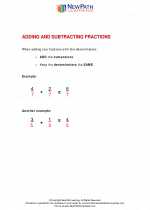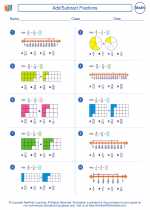Understanding Fractions
A fraction represents a part of a whole. The top number of a fraction is called the numerator, and it represents the part being considered. The bottom number is called the denominator and represents the total number of parts that make up the whole.
Adding Fractions
When adding fractions with the same denominator, you simply add the numerators together and keep the denominator the same. For example:
3/5 + 2/5 = (3 + 2)/5 = 5/5 = 1
When adding fractions with different denominators, you need to find a common denominator. To do this, you can find the least common multiple (LCM) of the denominators and then rewrite the fractions with the common denominator, before adding the numerators together. For example:
1/3 + 1/6 = 2/6 + 1/6 = 3/6 = 1/2
Subtracting Fractions
Subtracting fractions follows the same principles as adding fractions. When subtracting fractions with the same denominator, you simply subtract the numerators and keep the denominator the same. For example:
5/8 - 3/8 = (5 - 3)/8 = 2/8 = 1/4
When subtracting fractions with different denominators, you again need to find a common denominator before performing the subtraction. For example:
2/5 - 1/3 = 6/15 - 5/15 = 1/15
Practice Problems
Now let's practice with some problems:
- What is 1/4 + 2/5?
- What is 3/7 - 1/7?
- What is 2/3 + 3/4?
- What is 5/6 - 1/9?
Answers
- 1/4 + 2/5 = 13/20
- 3/7 - 1/7 = 2/7
- 2/3 + 3/4 = 17/12
- 5/6 - 1/9 = 43/54
Remember to always simplify your answers if possible by finding the greatest common divisor of the numerator and denominator and dividing both by it.
Practice makes perfect! Keep practicing to become a master at adding and subtracting fractions.
.◂Math Worksheets and Study Guides Fifth Grade. Add/Subtract Fractions

 Worksheet/Answer key
Worksheet/Answer key
 Worksheet/Answer key
Worksheet/Answer key
 Worksheet/Answer key
Worksheet/Answer key
